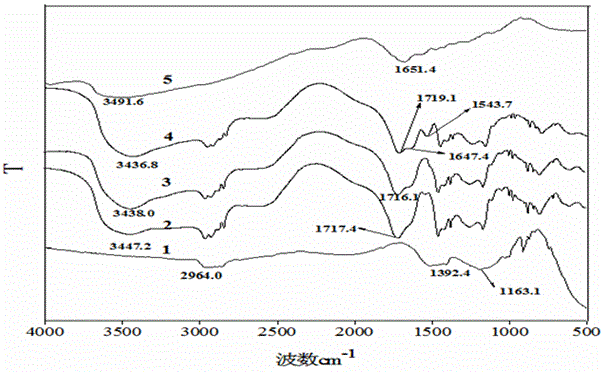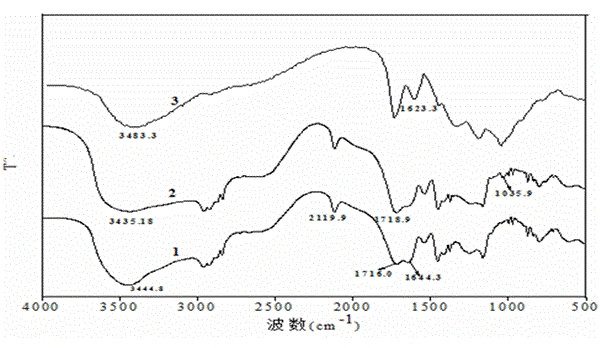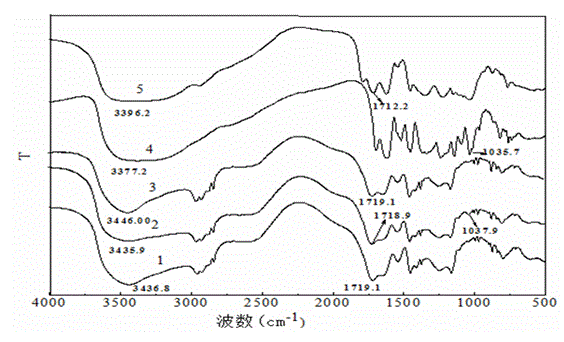Adsorbing material for azide method coupling gelatin and preparation method of adsorbing material
An adsorption material, gelatin technology, applied in chemical instruments and methods, other chemical processes, etc., can solve the problems of slow washing speed, high price, limited durability of adsorption materials, etc., and achieve low pressure loss of filtered water flow and high filtration stability The effect of sex and steric hindrance
- Summary
- Abstract
- Description
- Claims
- Application Information
AI Technical Summary
Problems solved by technology
Method used
Image
Examples
Embodiment 1
[0052] Example 1: The preparation method of the azide coupling gelatin adsorption material based on the carboxyl-diazonium salt electrostatic self-assembly on the surface of the non-woven fabric, the specific operation is as follows:
[0053] (1) Preparation of PP non-woven acrylic acid grafted product
[0054] Refer to the method in the Chinese patent application (application number 201010559722.2) "A high carboxyl content ion-exchange non-woven fabric and its preparation method", the specific operation is as follows:
[0055] A. Cut a batch of circular PP non-woven fabrics with a diameter of 8cm (commercially available, specification: 12.5g / m 2 , thickness 73.8 μm, water absorption rate 52.1%), soak in acetone for 12 hours, remove surface oil and additives and other impurities, take it out and dry it for later use;
[0056] B. Make a mixed solvent of acetone and distilled water according to 50% (volume percentage), add acrylic acid, benzophenone and azobisisobutyronitrile...
Embodiment 2
[0074] Example 2: The preparation method of the azide coupling gelatin adsorption material based on the carboxyl-diazonium salt electrostatic self-assembly on the surface of the non-woven fabric, the specific operation is as follows:
[0075] (1) Preparation of PP non-woven acrylic acid grafted product
[0076] Refer to the method in the Chinese patent application (application number 201010559722.2) "A high carboxyl content ion-exchange non-woven fabric and its preparation method", the specific operation is the same as the step (1) of Example 1, and this example uses polypropylene (PP) For non-woven fabrics, the carboxyl group-containing unsaturated monomer is acrylic acid, and the carboxyl group content Sg of the obtained PP non-woven fabric acrylic acid graft product is 10.3 mmol / g, and its water absorption rate is 485.4%.
[0077] (2) Preparation of p-phenylenediamine monodiazonium salt solution and electrostatic self-assembly of non-woven fabric grafted product and p-phe...
Embodiment 3
[0092] Example 3: The preparation method of the azide coupling gelatin adsorption material based on the carboxyl-diazonium salt electrostatic self-assembly on the surface of the non-woven fabric, the specific operation is as follows:
[0093] (1) Preparation of PP non-woven acrylic acid grafted product
[0094] Refer to the method in the Chinese patent application (application number 201010559722.2) "A high carboxyl content ion-exchange non-woven fabric and its preparation method", the specific operation is the same as the step (1) of Example 1, this example uses polypropylene (PP) For non-woven fabrics, the carboxyl group-containing unsaturated monomer is acrylic acid, and the carboxyl content Sg of the acrylic acid grafted product of the obtained PP non-woven fabric is 10.7 mmol / g, and its water absorption rate is 492.1%.
[0095] (2) Preparation of p-phenylenediamine monodiazonium salt solution and electrostatic self-assembly of non-woven fabric grafted product and p-phen...
PUM
| Property | Measurement | Unit |
|---|---|---|
| Diameter | aaaaa | aaaaa |
| Thickness | aaaaa | aaaaa |
| Adsorption capacity | aaaaa | aaaaa |
Abstract
Description
Claims
Application Information
 Login to View More
Login to View More - R&D
- Intellectual Property
- Life Sciences
- Materials
- Tech Scout
- Unparalleled Data Quality
- Higher Quality Content
- 60% Fewer Hallucinations
Browse by: Latest US Patents, China's latest patents, Technical Efficacy Thesaurus, Application Domain, Technology Topic, Popular Technical Reports.
© 2025 PatSnap. All rights reserved.Legal|Privacy policy|Modern Slavery Act Transparency Statement|Sitemap|About US| Contact US: help@patsnap.com



